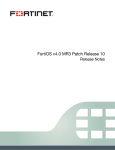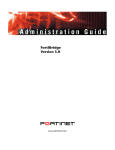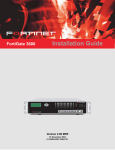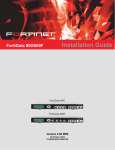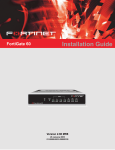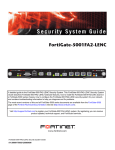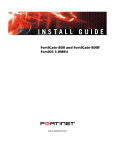Download Fortinet 3016B Network Card User Manual
Transcript
LED
Power
Status
MGMT1 and
MGMT2
(Right LED)
MGMT1 and
MGMT2
(Left LED)
State
Description
Green
The FortiGate unit is on.
Off
The FortiGate unit is off.
Green
The FortiGate unit is running normally.
Off
The FortiGate unit is off.
Green
The correct cable is in use and the connected equipment
has power.
Flashing Green
Network activity at this interface.
Off
No link established.
Green
Connection at 1000 Mb.
ASM
Esc
Amber
Connection at 100 Mb.
Off
Connection at 10 Mb.
Green
The correct cable is in use and the connected equipment
has power.
Flashing Green
Network activity at this interface.
Ports 1 to 16
CONSOLE
MGMT1
1
3
5
7
9
11
13
15
MODEM
MGMT2
2
4
6
8
10
12
14
16
Enter
POWER
STATUS
FortiGate-3016B
© Copyright 2008 Fortinet Incorporated. All rights reserved.
Products mentioned in this document are trademarks or registered trademarks of their respective holders.
Regulatory Compliance
FCC Class A Part 15 CSA/CUS
28 March 2008
01-30006-0402-20080328
Checking the Package Contents
Front
Connector
Type
Speed
Protocol
Description
MGMT1 and
MGMT2
RJ-45
10/100/1000
Base-T
Ethernet
Copper gigabit connection to 10/100/1000
copper networks.
ASM
Esc
Ports 1 to 16
LC SFP
CONSOLE
RJ-45
USB
USB
1000Base-SX
9600 bps
8/N/1
Ethernet
Multimode fiber optic connections to
gigabit optical networks for small packet
performance required for voice, video and
other multimedia streaming applications.
RS-232
serial
Optional connection to the management
computer. Provides access to the command line interface (CLI).
USB
Optional connection to a USB key for
firmware backup and installation.
Ethernet Cables:
Orange - Crossover
Grey - Straight-through
CONSOLE
MGMT1
1
3
5
7
9
11
13
15
MODEM
MGMT2
2
4
6
8
10
12
14
16
Enter
RJ-45 to
DB-9 Serial Cable
POWER
STATUS
Power Cables (2)
USB
LCD Display
Serial and
Modem Connections
Control Buttons
Fiber Ports
Copper
Management
Ports
4x Optical Transceivers
4x Copper Transceivers
Back
Rack-Mount Brackets
QuickStart Guide
USER MANUAL
FG-AMC-SW
Esc
CONSOLE
1
3
5
7
9
11
13
15
17
4
6
8
10
12
14
16
18
POWER
STATUS
Enter
MODEM
FortiGate-3016B
Copyright 2007 Fortinet Incorporated. All rights reserved.
Trademarks
Products mentioned in this document are trademarks.
Power
Connections
Documentation
Connecting
Connect the FortiGate unit to a power outlet and to the internal and external networks.
•
Place the unit on a stable surface.
•
Connect both power cables into the back of the FortiGate unit, then plug the power
cables into a power bar.
•
MAIN MENU appears when the unit is up and running.
•
If only one power supply is connected, an audible alarm sounds to indicate a failed
power supply. To stop this alarm, press the red alarm cancel button.
ASM
Esc
CONSOLE
MGMT1
1
3
5
7
9
11
13
15
MODEM
MGMT2
2
4
6
8
10
12
14
16
POWER
STATUS
Enter
Optional RJ-45 to DB-9 cable connects
to serial port on management computer
Straight-through Ethernet for access
to the web-based manager
Fiber optic cable connects
to internal network or Internet
Power alarm reset button
Power cables connect
to power outlets
Planning the Configuration
Before beginning to configure the FortiGate unit, you need to plan how to integrate the unit into your network. Your configuration plan is dependent upon the operating mode that you select:
NAT/Route mode (the default) or Transparent mode. Refer to the Documentation CD-ROM for information on how to control traffic, and how to configure HA, antivirus protection, FortiGuard,
Web content filtering, Spam filtering, intrusion prevention (IPS), and virtual private networking (VPN).
NAT/Route mode
Transparent mode
In NAT/Route mode, each FortiGate unit is visible to the network that it is connected to. All
of its interfaces are on different subnets. Each interface connected to a network must be
configured with an IP address that is valid for that network.
In Transparent mode, the FortiGate unit is invisible to the network. All of its interfaces are on
the same subnet. You only have to configure a management IP address so that you can make
configuration changes.
You would typically use NAT/Route mode when the FortiGate unit is deployed as a gateway
between private and public networks. In its default NAT/Route mode configuration, the unit
functions as a firewall. Firewall policies control communications through the FortiGate unit.
No traffic can pass through the FortiGate unit until you add firewall policies.
You would typically use the FortiGate unit in Transparent mode on a private network behind
an existing firewall or behind a router. In its default Transparent mode configuration, the unit
functions as a firewall. No traffic can pass through the FortiGate unit until you add firewall policies.
In NAT/Route mode, firewall policies can operate in NAT mode or in Route mode. In NAT
mode, the FortiGate unit performs network address translation before IP packets are sent to
the destination network. In Route mode, no translation takes place.
You can connect up to four network segments to the FortiGate unit to control traffic between
these network segments.
Internal Network
DMZ network
192.168.1.3
Web Server
Routing policies controlling
traffic between internal
networks.
Port 2
192.168.1.99
Port 1
204.23.1.5
Internet
Port 3
Mail Server
Poirt 1
Internet
Port 3
10.10.10.1
Internal
network
Router
Port 2
Hub or switch
Router
10.10.10.2
NAT mode policies controlling
traffic between internal
and external networks.
Internal
network
Choosing a Configuration Tool
Web-based manager
Command Line Interface (CLI)
The FortiGate web-based manager is an easy to use management tool.
Use it to configure the administrator password, the interface and default gateway addresses,
and the DNS server addresses.
The CLI is a full-featured management tool. Use it to configure the administrator password,
the interface addresses, default gateway address, and DNS server addresses. To configure
advanced settings, see the CLI Reference on the Tools and Documentation CD.
Requirements:
•
An Ethernet connection between the FortiGate unit and management computer.
•
Internet Explorer 6.0 or higher on the management computer.
Requirements:
•
The RJ-45 to DB-9 serial connection between the FortiGate unit and management
computer.
•
A terminal emulation application (HyperTerminal for Windows) on the management
computer.
Collecting Information
NAT/Route Mode
MGMT 1
MGMT 2
Port 1
Port 2
Port 3
Port 4
Port 5
Port 6
Port 7
IP:
____.____.____.____
Netmask:
____.____.____.____
IP:
____.____.____.____
Netmask:
____.____.____.____
IP:
____.____.____.____
Netmask:
____.____.____.____
IP:
____.____.____.____
Netmask:
____.____.____.____
IP:
____.____.____.____
Netmask:
____.____.____.____
IP:
____.____.____.____
Netmask:
____.____.____.____
IP:
____.____.____.____
Netmask:
____.____.____.____
IP:
____.____.____.____
Netmask:
____.____.____.____
IP:
____.____.____.____
Netmask:
____.____.____.____
Transparent mode
Port 8
Port 9
Port 10
Port 11
Port 12
Port 13
Port 14
Port 15
Port 16
Management IP
IP:
____.____.____.____
Netmask:
____.____.____.____
IP:
____.____.____.____
Netmask:
____.____.____.____
IP:
____.____.____.____
Netmask:
____.____.____.____
IP:
____.____.____.____
Netmask:
____.____.____.____
IP:
____.____.____.____
Netmask:
IP:
Netmask:
____.____.____.____
IP:
____.____.____.____
Netmask:
____.____.____.____
IP:
____.____.____.____
Netmask:
____.____.____.____
IP:
____.____.____.____
MGMT 1
192.168.1.99
Management IP
Netmask:
____.____.____.____
MGMT 2
192.168.2.99
Administrative account settings
IP:
____.____.____.____
Ports 1 to 16
0.0.0.0
User name
admin
Netmask:
____.____.____.____
Password
(none)
General settings
Administrator password
Default Gateway:
____.____.____.____
____.____.____.____
Primary DNS Server:
____.____.____.____
____.____.____.____
Secondary DNS Server:
____.____.____.____
Network Settings
A default gateway is required for the FortiGate unit to route connections to the Internet.
Factory default settings
NAT/Route mode
DHCP server on Internal
interface
Transparent mode
0.0.0.0
192.168.1.110 – 192.168.1.210
Configuring the FortiGate Unit
Web-based Manager
Command Line Interface
1.
1.
2.
3.
4.
Connect the FortiGate internal interface to a management computer Ethernet interface.
Use a cross-over Ethernet cable to connect the devices directly. Use straight-through
Ethernet cables to connect the devices through a hub or switch.
Configure the management computer to be on the same subnet as the internal
interface of the FortiGate unit. To do this, change the IP address of the management
computer to 192.168.1.2 and the netmask to 255.255.255.0.
To access the FortiGate web-based manager, start Internet Explorer and browse to
https://192.168.1.99 (remember to include the “s” in https://).
Type admin in the Name field and select Login.
2.
3.
4.
NAT/Route mode
1.
Configure the FortiGate internal interface.
config system interface
edit <port_num>
set ip <intf_ip>/<netmask_ip>
set allowaccess {http|https|ssh|ping|snmp|telnet}
end
2.
Configure the primary and secondary DNS server IP addresses.
config system dns
set primary <dns-server_ip>
set secondary <dns-server_ip>
end
3.
Configure the default gateway.
config router static
edit 1
set gateway <gateway_ip>
end
NAT/Route mode
To change the administrator password
1. Go to System > Admin > Administrators.
2. Select Change Password for the admin administrator and enter a new password.
To configure interfaces
1. Go to System > Network > Interface.
2. Select the edit icon for each interface to configure.
3. Set the addressing mode for the interface. (See the online help for information.)
•
For manual addressing, enter the IP address and netmask for the interface.
•
For DHCP addressing, select DHCP and any required settings.
•
For PPPoE addressing, select PPPoE, and enter the username and password
and any other required settings.
To configure the Primary and Secondary DNS server IP addresses
1. Go to System > Network > Options, enter the Primary and Secondary DNS IP addresses that you recorded above and select Apply.
To configure a Default Gateway
1. Go to Router > Static and select Edit icon for the static route.
2. Set Gateway to the Default Gateway IP address you recorded above and select OK.
Transparent mode
To switch from NAT/route mode to transparent mode
1. Go to System > Config > Operation Mode and select Transparent.
2. Set the Management IP/Netmask to 192.168.1.99/24.
3. Set a default Gateway and select Apply.
To change the administrator password
1. Go to System > Admin > Administrators.
2. Select Change Password for the admin administrator and enter a new password.
To change the management interface
1. Go to System > Config > Operation Mode.
2. Enter the Management IP address and netmask that you recorded above and select
Apply.
To configure the Primary and Secondary DNS server IP addresses
1. Go to System > Network > Options, enter the Primary and Secondary DNS IP addresses that you recorded above and select Apply.
7
Use the RJ-45 to DB9 serial cable to connect the FortiGate Console port to the management computer serial port.
Start a terminal emulation program (HyperTerminal) on the management computer. Use
these settings:
Baud Rate (bps) 9600, Data bits 8, Parity None, Stop bits 1, and Flow Control None.
At the Login: prompt, type admin and press Enter twice (no password required).
Transparent Mode
1.
Change from NAT/Route mode to Transparent mode and configure the Management IP
address.
config system settings
set opmode transparent
set manageip <mng_ip>/<netmask>
set gateway <gateway_ip>
end
2.
Configure the DNS server IP address.
config system dns
set primary <dns-server_ip>
set secondary <dns-server_ip>
end
Completing the Configuration
Congratulations!
You have finished configuring the basic settings. Your network is now protected from Internetbased threats. To explore the full range of configuration options, see the online help or the
Tools and Documentation CD.
Visit these links for more information and documentation for your Fortinet product.
• Technical Documentation - http://docs.forticare.com
• Fortinet Knowledge Center - http://kc.forticare.com
• Fortinet Technical Support - http://support.fortinet.com


